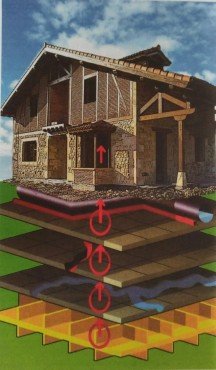Health and habitat are closely linked, since our health and that of other living beings depend on a series of environmental factors that directly or indirectly affect biological processes.
Geobiology as a science that studies the relationship between the energies of the Earth (Gea) and life (bios) focuses the analysis of the energy and vital quality of inhabited spaces and teaches us to distinguish and determine the different risk factors present in a home and health-promoting factors, thus acquiring information, knowledge and tools to determine the good places that allow us to enjoy maximum health and well-being in the spaces we inhabit.
One of the greatest challenges that we face when we address issues of geobiology and Biohabitability is to be able to know if a place is healthy for its inhabitants or there are risk factors that can seriously compromise -in the short or long term- health, becoming factors causing minor disorders or even serious diseases.
By learning to recognize the risk factors around the habitat by studying the knowledge that Geobiology gives us and learning to carry out geobiological surveys of houses and land to be built, we can become aware of the level of energy hygiene to which we are exposed in a certain inhabited space, be it a home, a workplace or a long-term space. Deepening in geobiological studies allows us to knowingly evaluate the different risk factors for health, detecting the possible existence of areas of intense terrestrial radiation or exposed to potentially geopathogenic geophysical alterations.
Training in geobiology and biohabitability offers us the possibility of developing our detection potentials based on personal sensitivity systems (dowsing), and we learn to recognize artificial risk factors with the use of measurement equipment that allow us to carry out environmental measurements of the electric and electromagnetic fields of inhabited environments and the levels of radioactivity to which we can be exposed.
Learning to develop personal sensitivity and with the management of the different detection systems and measurements of environmental radiation (natural and artificial), it is possible to determine the existence of altered or health-altering areas, determining the most optimal areas to locate the rooms. of our habitat, taking into account all those parameters that are necessary for a house to be favorable for the health of its inhabitants and for the environment, and meet the basic criteria of bio-habitability.

VIDEO ON GEOBIOLOGY AND BIOHABITABILITY by Mariano Bueno
December 18, 2021
- GEA News
- Others
Author: GEA
The geobiological studies association GEA has been developing and offering theoretical-practical training courses in Geobiology and Biohabitability for almost two decades, which allow the acquisition of knowledge that allows recognizing the different elements that promote health and well-being and being aware of the risk factors for health in the environment of homes.
More info on https://youtu.be/1zaozND4Bko

